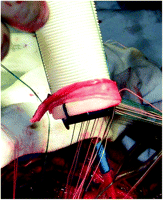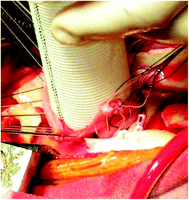-
PDF
- Split View
-
Views
-
Cite
Cite
Prashant N. Mohite, Shyam K. Thingnam, Samir Puri, Pravin P. Kulkarni, Use of pericardial strip for reinforcement of proximal anastomosis in Bentall's procedure, Interactive CardioVascular and Thoracic Surgery, Volume 11, Issue 5, November 2010, Pages 527–528, https://doi.org/10.1510/icvts.2010.243063
Close - Share Icon Share
Abstract
Bleeding from a proximal suture line is not uncommon following composite graft anastomosis in Bentall's procedure. Passage of valve sutures through the pericardial strip, which is used to encircle the sewing ring of the composite graft, strengthens the repair. The strip can also be sutured to the left ventricular outflow tract in case of bleeding from proximal anastomosis in that particular region.
1. Introduction
The Bentall procedure involves composite graft replacement of the aortic valve, aortic root and ascending aorta, with re-implantation of the coronary arteries into the graft. The Bentall procedure was first described in 1968 by Bentall and De Bono [1]. Bleeding through the proximal anastomotic site is not uncommon. Various techniques have been described in the literature to prevent and control the bleeding.
2. Technique
We use a 1-cm broad and 10–12-cm long strip of pericardium to encircle the valve sewing ring of the composite graft. The 2-0 pledgeted Ethibond sutures are initially passed through the left ventricular outflow tract, just below the annulus in an everted manner encompassing the aortic valve leaflets. The sutures are then passed through the pericardial strip after passing through the valve sewing ring of composite graft (see Fig. 1 ). Once all the sutures are passed, the composite graft is lowered along with the pericardial strip to sit over the left ventricular outflow tract (see Fig. 2 ). The sutures are then tied over the pericardial strip covering the sewing ring of the composite graft.

Passage of valve sutures through the pericardial strip encircling the valve sewing ring.

Fixing of valved conduit to left ventricular outflow tract with pericardial strip.
A pericardial strip helps secure the knots and offers strength to the repair. The pericardial strip distributes the tension over the knots equally. In case of bleeding from the proximal anastomosis, the pericardial strip can be sutured to the left ventricular outflow tract. The authors used this technique in their last 10 cases.
3. Discussion
Bleeding from proximal suture line is notorious following composite valve replacement of the ascending aorta and root. This consumes lot of operative time, needs excess blood and blood products transfusion, which has its own implications and complications. Sometimes it leads to alarming postoperative drainage mandating re-exploration. Many modifications have been suggested to prevent this complication. Bentall and De Bono wrapped the graft with native aneurysm wall, but the idea was soon abandoned because of development of hematoma between the graft and the wrap [1]. Cabrol et al. suggested anastomosing covered native aneurysm to the right atrium, but the procedure was found to be complicated by the development of persistent aorta to right atrial fistula [2].
Copeland et al. used a annular and supra-annular aortic wall tandem suture-lines technique which consists of using interrupted mattress sutures to anchor the lower part of the valve sewing ring to the aortic annulus. The upper part of the sewing ring is then anchored with a running suture line to the cut-edge of the supra-annular aortic wall [3]. Khanna and Akhter claimed to achieve similar effects without cutting the aortic wall by applying a purse string using 3/0 polypropylene suture through the aortic wall just above the proximal suture line and taking it out of the aortic wall through a polytetrafluoroethylene pledget [4].
Reinforcement suturing of the proximal anastomosis as mentioned in different techniques, is essentially difficult and frustrating because of lack of space and poor visibility in that region. We propose the technique of encircling a sewing ring of valved conduit with a pericardial strip and passing anastomosis sutures through it. It is a simple and reproducible technique which confers strength to the repair. In a case of bleeding from the proximal anastomosis, the pericardial strip can be sutured to the left ventricular outflow tract. As one margin of the pericardial strip is already fixed to the sewing ring of the valved conduit, it becomes easy to suture only the peripheral margin to the left ventricular outflow tract in the region of bleeding.
In addition, the authors avoided resecting the aortic valve leaflets before passing sutures through left ventricular outflow tract. The aortic valve leaflets encompassed into the left ventricular outflow tract sutures gives strength to the repair.




